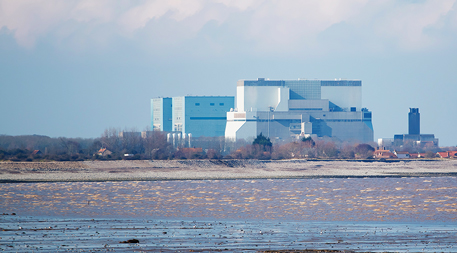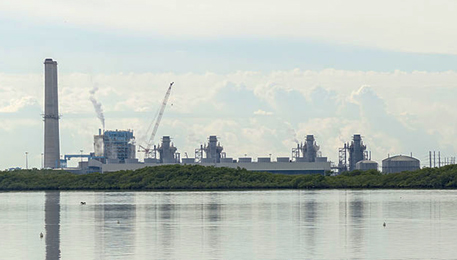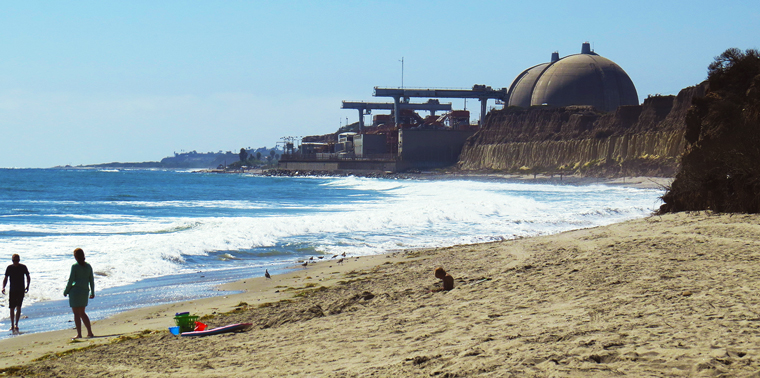August 8, 2018 — The outer defensive wall of what is expected to be the world’s most expensive nuclear power station is taking shape on the shoreline of the choppy gray waters of the Bristol Channel in western England.
By the time the US$25 billion Hinkley Point C nuclear station is finished, possibly in 2028, the concrete seawall will be 12.5 meters (41 feet) high, 900 meters (3,000 feet) long and durable enough, the UK regulator and French engineers say, to withstand the strongest storm surge, the greatest tsunami and the highest sea-level rise.
But will it? Independent nuclear consultant Pete Roche, a former adviser to the UK government and Greenpeace, points out that the tidal range along this stretch of coast is one of the highest in the world, and that erosion is heavy. Indeed, observers reported serious flooding on the site in 1981 when an earlier nuclear power station had to be shut down for a week. following a spring tide and a storm surge. However well built, says Roche, the new seawall does not adequately take into account sea-level rise due to climate change.

Hinkley Point C is now under construction at the Hinkley Point Nuclear Power Station on the shore of the Bristol Channel at Somerset, UK. Photo © iStockphoto.com/joegolby
“The wall is strong, but the plans were drawn up in 2012, before the increasing volume of melting of the Greenland ice cap was properly understood and when most experts thought there was no net melting in the Antarctic,” he says. “Now estimates of sea level rise in the next 50 years have gone up from less than 30 centimeters to more than a meter, well within the operating lifespan of Hinkley Point C — let alone in 100 years time when the reactors are finally decommissioned or the even longer period when spent nuclear fuel is likely to be stored on site.”
In fact, research by Ensia suggests that at least 100 U.S., European and Asian nuclear power stations built just a few meters above sea level could be threatened by serious flooding caused by accelerating sea-level rise and more frequent storm surges.
Some efforts are underway to prepare for increased flooding risk in the future. But a number of scientific papers published in 2018 suggest that climate change will impact coastal nuclear plants earlier and harder than the industry, governments or regulatory bodies have expected, and that the safety standards set by national nuclear regulators and the United Nations’ nuclear watchdog, the International Atomic Energy Agency (IAEA), are out of date and take insufficient account of the effects of climate change on nuclear power.
The Problem With Flooding
Flooding can be catastrophic to a nuclear power plant because it can knock out its electrical systems, disabling its cooling mechanisms and leading to overheating and possible meltdown and a dangerous release of radioactivity. Flooding at the Fukushima Daiichi plant in Japan as a result of the March 2011 tsunami caused severe damage to several of the plant’s reactors and only narrowly avoided a catastrophic release of radioactivity that could have forced the evacuation of 50 million people.
The interactive map above from Carbon Brief shows the location of nuclear power plants around the world. According to maps prepared by the World Association of Nuclear Operators (WANO), around one in four of the world’s 460 working commercial nuclear reactors are situated on coastlines. Many were built only 10–20 meters (30–70 feet) above sea level at a time when climate change was barely considered a threat.
In the U.S., where nine nuclear plants are within 2 miles (3 kilometers) of the ocean and four reactors have been identified by Stanford academics as vulnerable to storm surges and sea-level rise, flooding is common, says David Lochbaum, a former nuclear engineer and director of the nuclear safety project at the Union of Concerned Scientists (UCS).
Lochbaum says over 20 flooding incidents have been recorded at U.S. nuclear plants since the early 1980s. “The most likely [cause of flooding] is the increasing frequency of extreme events,” he says.
“There was no consideration of climate change when most U.S. plants were built,” says Natalie Kopytko, a University of Leeds researcher who has studied nuclear power plant adaptations to climate change. “They used conservative models of historical reference. Also, they were largely built at a calm period, when there were not many major storms.”
“While an accident has never yet happened due solely to sea-level rise and storms, the flooding experienced at Fukushima resembles what could occur in the future from sea-level rise,” says Kopytko.
Considering Climate Change
IAEA’s current global safety standards were published in 2011. These state that operators should only “take into account” the 18- to 59-centimeter (7- to 23-inch) sea-level rise projected by 2100 in the Intergovernmental Panel on Climate Change (IPCC)’s fourth assessment report, published in 2007.
But those safety standards don’t factor in the most recent assessment of the IPCC, published in 2013–14. This scientific consensus report has seas rising 26 centimeters (10 inches) to 1 meter (39 inches) by 2100, depending on how far temperature continue to rise and the speed at which the polar ice caps melt.
A 1-meter (39-inch) increase, combined with high tides and a storm surge, significantly increases the risk of coasts and nuclear stations being swamped, says Michael Mann, director of the Earth System Science Center at Pennsylvania State University.
“Nuclear stations are on the front line of climate change impacts both figuratively and quite literally,” Mann says. “We are likely profoundly underestimating climate change risk and damages in coastal areas.”
A recent study from NASA’s Goddard Space Flight Center expects the mean average rise to be a minimum of 65 centimeters (26 inches) by 2100.
“This 65-centimeter [rise] is almost certainly a conservative estimate,” says NASA lead author Steve Nerem, a professor of aerospace engineering sciences at the University of Colorado Boulder. “Our [study] assumes that sea level continues to change in the future as it has over the last 25 years. Given the large changes we are seeing in the ice sheets today, that’s not likely.”
A Matter of Timing
Sea-level rise, averaging 3 millimeters (0.1 inches) a year worldwide — but more or less in some places depending on topography and geography — is regarded by the two global nuclear trade bodies as a future, rather than a present risk.
“The IPCC says sea-level rise is not expected to kick in for some time. It’s a very long timeline,” says WANO spokesperson Tim Jeffery.
Most reactors, says Jonathan Cobb of the World Nuclear Association, will have been long decommissioned by the time any significant sea-level rise takes place. “The industry has been taking climate change impacts into account and taking action,” Cobb says. “This has happened both before and after the Fukushima accident.”
Flooding already is becoming much more frequent along the U.S. coastline. However, flooding already is becoming much more frequent along the U.S. coastline. According to the U.S. Environmental Protection Agency (EPA), nearly all of 27 regularly measured coastal sites have experienced a significant increase in flooding since the 1950s, with the rate accelerating in many locations along the East and Gulf Coasts where many reactors are situated.
The most comprehensive research yet conducted also shows sea-level rises are accelerating as ice caps melt. Such is the speed of ice melt observed since 2007 that even the 2013 IPCC estimates of sea-level rise are thought to be outdated.
“There has been a steep increase in ice losses from Antarctica during the past decade, and the continent is causing sea levels to rise faster today than at any time in the past 25 years. This has to be a concern for the governments we trust to protect our coastal cities and communities,” says joint lead author Andrew Shepherd, professor of earth observation at the University of Leeds and principal scientific advisor to the European Space Agency.
Sea-level rise was not considered when the first British and U.S. nuclear stations were built in the 1960s. In the UK, analysis by the government’s floods and coastal erosion team found in 2012 that 12 of the country’s 19 nuclear plants would be at risk of erosion or coastal flooding by the 2080s without more protection. Those at Bradwell, Hinkley Point, Hartlepool, Sizewell, Dungeness and Oldbury were considered “high risk.”
Threats From Storms
On top of sea-level rise, the added impact of flooding from storm surges must be considered as well, scientists say. Since 1970, the magnitude and frequency of extreme sea levels (ESLs, a factor of mean sea level, tide and storm-induced increases), which can cause catastrophic flooding, have increased throughout the world, according to the Global Extreme Sea Level Analysis project. New satellite studies by the U.S. government’s National Oceanic and Atmospheric Administration (NOAA), NASA, and other leading scientific institutions all show mean sea level rising and magnifying the frequency and severity of ESLs.
The destructive power of the typhoons that regularly wreak havoc across China, Japan, Korea and the Philippines has intensified by 12 to 15 percent in the past 40 years with the proportion of category 4 and 5 storms doubling or tripling. Similarly, many of the most severe recorded Atlantic hurricane seasons have taken place since 2003. And new research suggests that every 1.8 °F (1 °C) increase in global average temperatures could lead, via increased sea level and more severe storms, to a two- to sevenfold increase in the risk of surges that are the magnitude of those caused by Hurricane Katrina, which struck New Orleans and other U.S. southern coastal cities in 2005.

The Turkey Point nuclear power plant in Florida is among those considered most vulnerable to storm surges. Photo courtesy of Acroterion, Wikimedia Commons
Some individual U.S. plants are highly vulnerable, says Kopytko. Using the global average of an annual 3-millimeter (0.1-inch) sea-level rise and taking into account natural subsidence and the latest storm data and surge levels, she calculated in 2015 that several U.S. coastal plants could be inundated by storm surges. These included the St. Lucie and Turkey Point stations in Florida.
Her research, published in the Bulletin of the Atomic Scientists, supports a 2012 Stanford University study that showed that many coastal nuclear plants are more vulnerable to inundation than was Fukushima Daiichi, including the Salem and Hope Creek nuclear plants in New Jersey, the Millstone station in Connecticut, and the Seabrook reactors in New Hampshire.
While no nuclear power plant has been in imminent danger of a meltdown because of a storm surge, there have been many close calls. Three U.S. nuclear power reactors were temporarily shut down because of Hurricane Sandy in 2012 and a fourth, Oyster Creek in New Jersey, was put on alert when water levels rose dramatically, according to the U.S. Nuclear Regulatory Commission (NRC).
The closest any U.S. station may have come to a storm-related disaster was in 1992 when Hurricane Andrew hit Florida’s Turkey Point plant. Wind gusts of 175 miles per hour (282 kilometers per hour) and a 16-foot (4.9-meter) surge did only limited damage, but if the sea levels had been as high as are now projected, it could have led to a major disaster, according to Lochbaum.
“Hurricane Andrew is historic because this is the first time that a hurricane significantly affected a commercial nuclear power plant,” wrote the NRC in a 1993 review of how Turkey Point fared during the emergency. None of the essential safety features was compromised during the storm, and the nuclear units, which had been shut down hours before the hurricane arrived, remained in a stable condition.
In 2006, if Typhoon Saomai — one of the strongest storms to hit China in 50 years, with 3.76-meter (12-foot) storm surges and 7-meter (23-foot) waves that caused 240 deaths and sank 952 ships — had landed two hours later on the coast it would have coincided with a spring tide and would almost certainly have inundated the reactors at Qinshan nuclear plant, says researcher Liu Defu of the Ocean University of China at Qingdao.
Reassess and Improve
The IAEA advised the 31 countries that generate commercial nuclear power to reassess their safety after the Fukushima disaster in 2011. Within days of the 2011 earthquake, China suspended approvals for new plant construction and temporarily stopped work pending tests at plants under construction.
Stress tests on reactors demanded by the IAEA and nuclear regulators after Fukushima forced the world’s nuclear operators to reassess and improve their emergency control measures, including those related to flooding. One aging British station at Dungeness, for instance, was shut down for two months in 2013 while extra flood protection measures were set in to place in the wake of the Fukushima disaster.
Since the Fukushima incident, all coastal nuclear plants have installed more powerful pumps, upgraded power supplies, and installed waterproof doors and moveable flood barriers.Since the Fukushima incident, all coastal nuclear plants have installed more powerful pumps, upgraded power supplies, and installed waterproof doors and moveable flood barriers, says the World Nuclear Association’s Cobb.
“In response to the accident [at Fukushima], reviews took place at reactors around the world, including checks of flood defenses and robustness of back-up power supplies — the so-called stress tests,” he says.
In the U.S., the NRC ordered operators to tighten their safety plans after Fukushima and Hurricane Sandy. New back-up equipment to handle flooding was installed, substations and generating stations were shored up, new batteries installed and access roads strengthened, says NRC spokesperson Scott Burnell.
“All U.S. coastal nuclear facilities are built to withstand the worst-case storm scenario,” Burnell says. “Every U.S. reactor site has completed its flooding hazard re-analysis. Forty of 49 sites have completed required focused evaluations of local intense precipitation and the plants’ available margin to safely deal with the updated hazard. These include for sea-level rise and related effects such as storm surge.”
However, few regulatory authorities around the world appear to have specifically asked operators to increase their defenses against climate-change-related dangers.
“Steps have been taken to lessen vulnerability to flooding at nuclear plants, but problems remain,” says UCS’s Lochbaum. “More portable power supplies, to give people more chance to respond to flooding have been installed. But pumps have been found to be inadequate. People spent a lot of money on new equipment after Fukushima, but it’s not always working.”
“The plant operators understand the problems of sea-level rise and extreme events,” he adds. “They look at Fukushima and take note. They have billions of dollars in assets and they don’t want to lose them. But if the regulator doesn’t require a more robust structure then it’s up to the operator, and they have shallow pockets.”
A Look to the Future
According to the World Nuclear Association, some 50 nuclear power plants are now under construction, with roughly another 150 planned. Many of the world’s new nuclear plants are being built on the coasts of Asian countries, which face floods, sea-level rise and typhoons. At least 15 of China’s 39 reactors in operation, and many of the plants it has under construction, are on the coast.
According to an IAEA spokesman, Jeffrey Donovan, the agency’s Department of Nuclear Energy hopes to publish later this year a study on how nuclear power and other energy facilities can adapt to climate change, including rising sea levels.
“Changes are happening faster than expected,” says Myles Allen, head of the Climate Dynamics Group at Oxford University’s department of physics and lead author of the upcoming IPCC 1.5 °C special report. “Standards must take climate change into account.” ![]()
UPDATED 08.15.18: The spelling of the location of Ocean University of China was corrected to Qingdao.
Ensia shares solutions-focused stories free of charge through our online magazine and partner media. That means audiences around the world have ready access to stories that can — and do — help them shape a better future. If you value our work, please show your support today.
Yes, I'll support Ensia!

Radioactivity must not enter the rivers and seas that host a vital part of the human food chain. Yet the politicians and nuclear interests have failed to grasp that all coastal npps must be decommissioned and the sites cleared of all radioactive material _before_ the worst-case combination of sea level rise and storm surge occurs. As such clearance may take 50 years or more, this means that many such npps must be shut down at once.
This conflict of governmental interest supports "nuclear exceptionalism": the practice of directing attention away from nuclear power's record of saving real human lives with dishonest appeals to danger-in-theory, e.g. the assertion that 50 million people might have had to be evacuated in Japan.
1958 -- fifty years ago -- the threats of climate change were well understood and well documented, merely ignored or disbelieved or evaded to escape paying the cost or to obtain the profits of pretending the knowledge wasn't there.
No drug would make it to market today -- much less in 1958 -- were the same warning signs about it present as about the climate threat to nuclear plants; no car would be considered roadworthy.
This is shoddy engineering, failing the principle of RALARA - Risk As Low As Reasonably Achievable which is supposed to guide the nuclear industry. It is shoddy governance by elected officials and their appointees.
We have to stop making excuses and start making safe nuclear, or no nuclear at all until RALARA. In an age of cheap, reliable renewables, it costs us nothing to terminate or postpone nuclear.
Sea temperature changes are far more tolerable to nuclear plants than river water changes. Secondly, all the plants in France shutdown were because of *regulatory* requirements, not because it effected the reactors at all. (High condenser inlet water temps do effect efficiency of the turbine/generators however, but not the reactor).
I actually found the links provided helpful in the article. I took away from this article that the industry, globally, IS stepping up to the challenge.